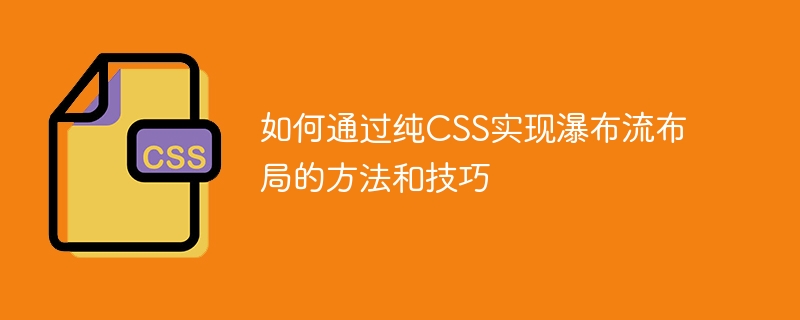

Methods and techniques on how to implement waterfall flow layout through pure CSS
Waterfall layout (Waterfall Layout) is a common layout method in web design. By arranging content in multiple columns, each column is of inconsistent height, creating a waterfall-like visual effect. This layout is often used in situations where a large amount of content needs to be displayed, such as picture display and product display, and has a good user experience.
There are many ways to implement waterfall flow layout, which can be done using JavaScript or CSS. This article will focus on the methods and techniques of implementing waterfall flow layout through pure CSS, and attach specific code examples.
First, we need to create a container element to wrap all the content. We can use a div element and give it a unique class or id to identify it to facilitate selection in CSS.
Next, we need to define the style of each column. Similar to grid layout, we can use the column property of CSS to implement multi-column layout. In a waterfall layout, the width of each column can be adjusted according to actual needs, and the break-inside attribute can also be used to ensure that the content is arranged correctly in the column.
.waterfall-container { column-count: 3; /* 设置为3列 */ column-gap: 20px; /* 设置列之间的间距 */ break-inside: avoid; /* 避免内容跨列显示 */ }
Now that we have created the basis of a multi-column layout, the next step is how to achieve inconsistent heights in each column to form a waterfall effect. To achieve this, we can use the trick of CSS pseudo-elements.
First, we need to create a pseudo element for each column and give it a fixed height and background color. This pseudo-element will act as the background for each column, and we can style it to be absolutely positioned and fill the entire column.
.waterfall-container::before { content: ''; position: absolute; top: 0; bottom: 0; width: 100%; background-color: #f2f2f2; /* 设置背景颜色 */ }
Next, we need to set a different height for each content item and display it in the corresponding column. This step can be achieved by setting different style classes for the content items in each column. In CSS, we can use the nth-child selector to select elements at specific positions and then set different heights for these elements.
.waterfall-container .content-column1 .content-item:nth-child(2n+1) { height: 200px; } .waterfall-container .content-column1 .content-item:nth-child(2n) { height: 250px; } .waterfall-container .content-column2 .content-item:nth-child(3n+1) { height: 180px; } .waterfall-container .content-column2 .content-item:nth-child(3n+2) { height: 230px; } .waterfall-container .content-column2 .content-item:nth-child(3n) { height: 210px; } .waterfall-container .content-column3 .content-item:nth-child(4n+1) { height: 220px; } .waterfall-container .content-column3 .content-item:nth-child(4n+2) { height: 270px; } .waterfall-container .content-column3 .content-item:nth-child(4n+3) { height: 240px; }
Finally, we need to add the content items to the corresponding columns. In HTML, we can do this using elements such as unordered lists (ul) and list items (li). And add the corresponding style class for each list item to ensure that they display in the correct column.
- 内容项1
- 内容项2
- 内容项3
- 内容项4
- 内容项5
- 内容项6
- 内容项7
- 内容项8
- 内容项9
In this way, we successfully implemented the waterfall flow layout through pure CSS. By properly defining the styles of each column and setting different heights for each content item, we can easily create a beautiful waterfall effect.
To summarize, the key to achieving waterfall flow layout lies in multi-column layout and content items of different heights. By using the CSS column attribute and pseudo-element, and combining the nth-child selector and class selector, we can achieve a concise and flexible waterfall layout.
I hope this article will help you understand and apply pure CSS to implement waterfall flow layout. By reasonably adjusting the style and content items, you can also customize and expand it according to your own needs. I wish you better results in web design!
The above is the detailed content of Methods and techniques on how to implement waterfall flow layout through pure CSS. For more information, please follow other related articles on the PHP Chinese website!




